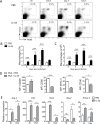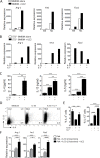IL-33-mediated protection against experimental cerebral malaria is linked to induction of type 2 innate lymphoid cells, M2 macrophages and regulatory T cells
- PMID: 25659095
- PMCID: PMC4450060
- DOI: 10.1371/journal.ppat.1004607
IL-33-mediated protection against experimental cerebral malaria is linked to induction of type 2 innate lymphoid cells, M2 macrophages and regulatory T cells
Abstract
Cerebral malaria (CM) is a complex parasitic disease caused by Plasmodium sp. Failure to establish an appropriate balance between pro- and anti-inflammatory immune responses is believed to contribute to the development of cerebral pathology. Using the blood-stage PbA (Plasmodium berghei ANKA) model of infection, we show here that administration of the pro-Th2 cytokine, IL-33, prevents the development of experimental cerebral malaria (ECM) in C57BL/6 mice and reduces the production of inflammatory mediators IFN-γ, IL-12 and TNF-α. IL-33 drives the expansion of type-2 innate lymphoid cells (ILC2) that produce Type-2 cytokines (IL-4, IL-5 and IL-13), leading to the polarization of the anti-inflammatory M2 macrophages, which in turn expand Foxp3 regulatory T cells (Tregs). PbA-infected mice adoptively transferred with ILC2 have elevated frequency of M2 and Tregs and are protected from ECM. Importantly, IL-33-treated mice deleted of Tregs (DEREG mice) are no longer able to resist ECM. Our data therefore provide evidence that IL-33 can prevent the development of ECM by orchestrating a protective immune response via ILC2, M2 macrophages and Tregs.
Conflict of interest statement
The authors have declared that no competing interests exist.
Figures








Similar articles
-
Pre-existing Schistosoma japonicum infection alters the immune response to Plasmodium berghei infection in C57BL/6 mice.Malar J. 2013 Sep 14;12:322. doi: 10.1186/1475-2875-12-322. Malar J. 2013. PMID: 24034228 Free PMC article.
-
Natural regulatory T cells mediate the development of cerebral malaria by modifying the pro-inflammatory response.Parasitol Int. 2010 Jun;59(2):232-41. doi: 10.1016/j.parint.2010.02.007. Epub 2010 Feb 26. Parasitol Int. 2010. PMID: 20219695
-
Role of IL-10-producing regulatory B cells in control of cerebral malaria in Plasmodium berghei infected mice.Eur J Immunol. 2013 Nov;43(11):2907-18. doi: 10.1002/eji.201343512. Epub 2013 Aug 27. Eur J Immunol. 2013. PMID: 23893352
-
Parasite densities modulate susceptibility of mice to cerebral malaria during co-infection with Schistosoma japonicum and Plasmodium berghei.Malar J. 2014 Mar 26;13:116. doi: 10.1186/1475-2875-13-116. Malar J. 2014. PMID: 24670210 Free PMC article.
-
Unravelling the roles of innate lymphoid cells in cerebral malaria pathogenesis.Parasite Immunol. 2018 Feb;40(2). doi: 10.1111/pim.12502. Parasite Immunol. 2018. PMID: 29117626 Review.
Cited by
-
Dual Immune Regulatory Roles of Interleukin-33 in Pathological Conditions.Cells. 2022 Oct 14;11(20):3237. doi: 10.3390/cells11203237. Cells. 2022. PMID: 36291105 Free PMC article. Review.
-
Group 2 Innate Lymphoid Cells Exacerbate Amebic Liver Abscess in Mice.iScience. 2020 Sep 8;23(9):101544. doi: 10.1016/j.isci.2020.101544. eCollection 2020 Sep 25. iScience. 2020. PMID: 33083770 Free PMC article.
-
Interaction Between Innate Lymphoid Cells and the Nervous System.Adv Exp Med Biol. 2022;1365:135-148. doi: 10.1007/978-981-16-8387-9_9. Adv Exp Med Biol. 2022. PMID: 35567745 Review.
-
Pathogenetic mechanisms and treatment targets in cerebral malaria.Nat Rev Neurol. 2023 Nov;19(11):688-709. doi: 10.1038/s41582-023-00881-4. Epub 2023 Oct 19. Nat Rev Neurol. 2023. PMID: 37857843 Review.
-
Innate cell communication kick-starts pathogen-specific immunity.Nat Immunol. 2016 Apr;17(4):356-63. doi: 10.1038/ni.3375. Nat Immunol. 2016. PMID: 27002843 Free PMC article. Review.
References
-
- World Health Organization (2012) World Malaria Report 2012.
Publication types
MeSH terms
Substances
Grants and funding
LinkOut - more resources
Full Text Sources
Other Literature Sources
Molecular Biology Databases

